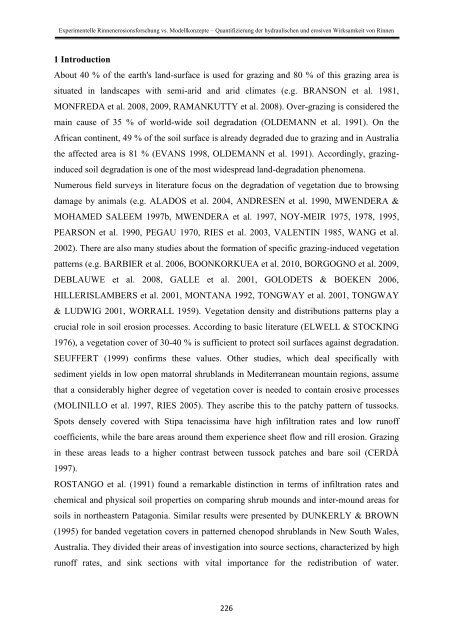Stefan Wirtz Vom Fachbereich VI (Geographie/Geowissenschaften ...
Stefan Wirtz Vom Fachbereich VI (Geographie/Geowissenschaften ...
Stefan Wirtz Vom Fachbereich VI (Geographie/Geowissenschaften ...
You also want an ePaper? Increase the reach of your titles
YUMPU automatically turns print PDFs into web optimized ePapers that Google loves.
Experimentelle Rinnenerosionsforschung vs. Modellkonzepte – Quantifizierung der hydraulischen und erosiven Wirksamkeit von Rinnen<br />
1 Introduction<br />
About 40 % of the earth's land-surface is used for grazing and 80 % of this grazing area is<br />
situated in landscapes with semi-arid and arid climates (e.g. BRANSON et al. 1981,<br />
MONFREDA et al. 2008, 2009, RAMANKUTTY et al. 2008). Over-grazing is considered the<br />
main cause of 35 % of world-wide soil degradation (OLDEMANN et al. 1991). On the<br />
African continent, 49 % of the soil surface is already degraded due to grazing and in Australia<br />
the affected area is 81 % (EVANS 1998, OLDEMANN et al. 1991). Accordingly, grazinginduced<br />
soil degradation is one of the most widespread land-degradation phenomena.<br />
Numerous field surveys in literature focus on the degradation of vegetation due to browsing<br />
damage by animals (e.g. ALADOS et al. 2004, ANDRESEN et al. 1990, MWENDERA &<br />
MOHAMED SALEEM 1997b, MWENDERA et al. 1997, NOY-MEIR 1975, 1978, 1995,<br />
PEARSON et al. 1990, PEGAU 1970, RIES et al. 2003, VALENTIN 1985, WANG et al.<br />
2002). There are also many studies about the formation of specific grazing-induced vegetation<br />
patterns (e.g. BARBIER et al. 2006, BOONKORKUEA et al. 2010, BORGOGNO et al. 2009,<br />
DEBLAUWE et al. 2008, GALLE et al. 2001, GOLODETS & BOEKEN 2006,<br />
HILLERISLAMBERS et al. 2001, MONTANA 1992, TONGWAY et al. 2001, TONGWAY<br />
& LUDWIG 2001, WORRALL 1959). Vegetation density and distributions patterns play a<br />
crucial role in soil erosion processes. According to basic literature (ELWELL & STOCKING<br />
1976), a vegetation cover of 30-40 % is sufficient to protect soil surfaces against degradation.<br />
SEUFFERT (1999) confirms these values. Other studies, which deal specifically with<br />
sediment yields in low open matorral shrublands in Mediterranean mountain regions, assume<br />
that a considerably higher degree of vegetation cover is needed to contain erosive processes<br />
(MOLINILLO et al. 1997, RIES 2005). They ascribe this to the patchy pattern of tussocks.<br />
Spots densely covered with Stipa tenacissima have high infiltration rates and low runoff<br />
coefficients, while the bare areas around them experience sheet flow and rill erosion. Grazing<br />
in these areas leads to a higher contrast between tussock patches and bare soil (CERDÀ<br />
1997).<br />
ROSTANGO et al. (1991) found a remarkable distinction in terms of infiltration rates and<br />
chemical and physical soil properties on comparing shrub mounds and inter-mound areas for<br />
soils in northeastern Patagonia. Similar results were presented by DUNKERLY & BROWN<br />
(1995) for banded vegetation covers in patterned chenopod shrublands in New South Wales,<br />
Australia. They divided their areas of investigation into source sections, characterized by high<br />
runoff rates, and sink sections with vital importance for the redistribution of water.<br />
226
















